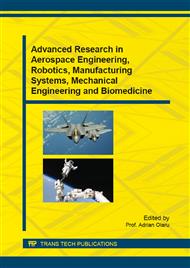[1]
J. Ni, W. Wu, J. Shen, X. Fan, An improved VFF approach for robot path planning in unknown and dynamic environments, Mathematical Problems in Engineering (2014) 1-10.
DOI: 10.1155/2014/461237
Google Scholar
[2]
J. Pérez, J. Godoy, J. Villagra, E. Onieva, Trajectory generator for autonomous vehicles in urban environments, IEEE International Conference Robotics and Automation (2013) 409-414.
DOI: 10.1109/icra.2013.6630608
Google Scholar
[3]
N. Rivera, L. Illanes, J.A. Baier, Real-Time Pathfinding in Unknown Terrain via Reconnection with an Ideal Tree, Advances in Artificial Intelligence (2014) 69-80.
DOI: 10.1007/978-3-319-12027-0_6
Google Scholar
[4]
R.R. Radaelli, C. Badue, M.A. Gonçalves, T. Oliveira-Santos, A.F. De Souza, A Motion Planner for Car-Like Robots Based on Rapidly-Exploring Random Trees, Advances in Artificial Intelligence (2014) 469-480.
DOI: 10.1007/978-3-319-12027-0_38
Google Scholar
[5]
M. Xu, J. Lee, S.K. Bahn, B.Y. Kang, Path planning for robot using Population-Based Incremental Learning, Cyber Technology in Automation, Control, and Intelligent Systems (2014) 474-479.
DOI: 10.1109/cyber.2014.6917510
Google Scholar
[6]
B.Y. Kang, M. Xu, J. Lee, D.W. Kim, ROBIL: Robot Path Planning Based on a PBIL Algorithm, International Journal of Advanced Robotic Systems 11 (2014) 1-14.
DOI: 10.5772/58872
Google Scholar
[7]
Y. Alon, A. Ferencz, A. Shashua, Off-road path following using region classification and geometric projection constraints, Computer Vision and Pattern Recognition 1 (2006) 689-696.
DOI: 10.1109/cvpr.2006.213
Google Scholar
[8]
M. Reiter, D. Abel, Two and a half carrots-a versatile and intuitive optimisation-based path-following approach for road vehicles, Control and Automation (2015) 364-370.
DOI: 10.1109/med.2015.7158776
Google Scholar
[9]
E. Boix ,A. Ferrer, S. Fernandez, X. Sellart, Vehicle Guiding System Through Image Processing in Crash and Misuse Tests. Proceedings of SAE-China Congress (2015) 411-424.
DOI: 10.1007/978-3-662-45043-7_42
Google Scholar
[10]
A. Aswani, C. TOMLIN, Game-theoretic routing of GPS-assisted vehicles for energy efficiency, American Control Conference (2011) 3375-3380.
DOI: 10.1109/acc.2011.5991396
Google Scholar
[11]
T. Gîrbacia, G. Mogan, An Improvement of the Rapidly-Exploring Random Tree Method for Path Planning of a Car-Like Robot in Virtual Environment, Applied Mechanics and Materials 772 (2015) 471-476.
DOI: 10.4028/www.scientific.net/amm.772.471
Google Scholar
[12]
A. Margarit, M. Simion: Design and development of autonomous minivehicle-hardware and simulation, Master Thesis, Transilvania, University, Brasov (2015).
Google Scholar


